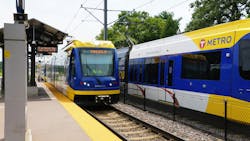METRO Green Line Extension enters testing phase as construction nears completion
The Metropolitan Council (Met Council) announced that the first light-rail trains are now rolling on the METRO Green Line Extension for track, signal and system testing ahead of a predicted 2027 launch. The METRO Green Line Extension will connect the southwest metro to the region's existing light-rail network via 16 stations across Minneapolis, St. Louis Park, Hopkins, Minnetonka and Eden Prairie.
Construction on the 14.5-mile extension, connecting Target Field in downtown Minneapolis to Eden Prairie, is 95% complete and has been cleared to enter the testing phase. Testing will continue through 2026.
Beyond the expanding transit options, the agency says the corridor is experiencing significant growth. As the transit project progresses, $3.1 billion in housing, shopping and leisure projects have already been built, are under construction, or are permitted while another $700 million in new investments are in the planning phase with developers.
"Projects like the METRO Green Line Extension are smart investments in our region's future," said Met Council Interim Chair Deb Barber. "They connect homes to businesses, schools to hospitals and communities to opportunities—and those connections attract even more investment. The numbers tell the story: land near METRO transit projects represents just 2% of taxable property in the region yet generates 20% of our property tax revenue."
“The burden of car ownership is becoming more costly for residents and our environment,” said Hennepin County Commissioner Marion Greene. “Light rail is a reliable, affordable and environmentally sound transportation option that provides an undeniable return on investment. Generational investments like the Green Line Extension will pay dividends for decades to come, fueling our regional economy, reducing congestion and greenhouse gas emissions and bolstering our state for the future.”
Transforming communities
The Met Council notes each city along the corridor is experiencing significant development spurred by the transit investment:
Eden Prairie – $560 million in new development
- 1,000 new multi-family units, including 140 affordable units
- $316 million in commercial development
- $36 million in industrial projects
Minnetonka – Over $373 million in new development
- 1,700 new multi-family housing units, including 530 affordable units
- $92 million in commercial development
- $14 million in industrial investment
Hopkins – Over $329 million in new development
- 1,300 new multi-family housing units, including 260 affordable units
- $27 million in commercial development
- $9 million in industrial investment
Saint Louis Park – Over $497 million in new development
- 1,500 new multi-family housing units, including 290 affordable units
- $48 million in commercial development
- $24 million in industrial investment
- $170 million in public and institutional projects
Minneapolis – $1.37 billion in new development
- Over 3,800 new multi-family housing units, including 660 affordable units
- $477 million in commercial development
- $28 million in industrial development
“The Hopkins community is excited about the return of passenger trains to Hopkins, as well as the economic growth it is bringing,” said Hopkins Mayor Patrick Hanlon. “Our city’s name actually came from a train station. Our community was born a bustling city on a train line as a market and art center built for the pedestrian experience. In 2027, we are returning home to our rightful place as that bustling city on a train line.”
The near completion of the Green Line Extension marks a big year for the METRO system. In 2025, the METRO Gold Line began passenger service in the east metro area, connecting St. Paul to Woodbury, and the METRO B Line began serving the corridor between South Minneapolis and downtown St. Paul. Before year's end, the METRO E Line will launch, making a connection between the University of Minnesota and Edina.
